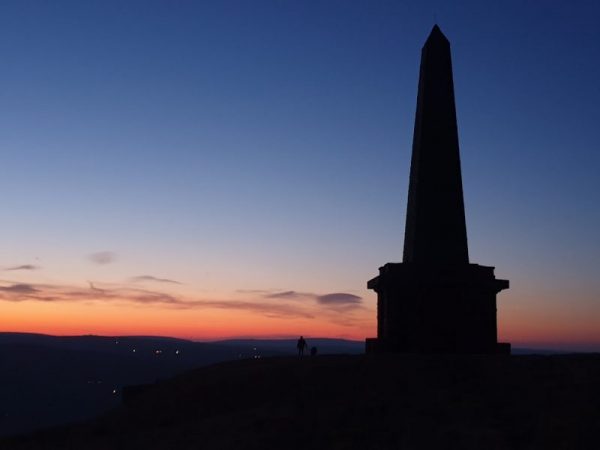
Mid-distance shot of Stoodley Pike
|
|
| Coordinates | 53.714°N 2.0424°WCoordinates: 53.714°N 2.0424°W |
|---|---|
| Location | Mankinholes, West Yorkshire, England |
| Height | 121 metres (397 ft) |
Stoodley Pike is a 1,300-foot (400 m) hill in the south Pennines in West Yorkshire in northern England. It is noted for the 121-foot (37 m)[1] Stoodley Pike Monument at its summit, which dominates the moors of the upper Calder Valley and the market town of Todmorden. The monument is near the villages of Mankinholes and Lumbutts, West Yorkshire, and was designed in 1854 by local architect John Green, and completed in 1856 at the end of the Crimean War.
The monument replaced an earlier structure, started in 1814 and commemorating the defeat of Napoleon and the surrender of Paris.[2] It was completed in 1815, after the Battle of Waterloo (Napoleonic Wars), but collapsed in 1854 after an earlier lightning strike, and decades of weathering.[3] Its replacement was therefore built slightly further from the edge of the hill. During repair work in 1889 a lightning conductor was added, and although the tower has since been struck by lightning on numerous occasions, no notable structural damage is evident. There is evidence to suggest that some sort of structure existed on the site even before the earlier structure was built. The monument is approximately 2 miles (3.2 km) south west of Hebden Bridge and approximately 2.5 miles (4 km) east of Todmorden town centre. The monument was Grade II listed in 1984.[4]
The inscription above the entrance is worn and covered with lichen but it is legible and reads:
STOODLEY PIKE
A PEACE MONUMENT
ERECTED BY PUBLIC SUBSCRIPTION
COMMENCED IN 1814 TO COMMEMORATE
THE SURRENDER OF PARIS TO THE ALLIES
AND FINISHED AFTER THE BATTLE OF
WATERLOO WHEN PEACE WAS ESTABLIS-
HED IN 1815. BY A STRANGE COINCIDENCE
THE PIKE FELL ON THE DAY THE RUSSIAN
AMBASSADOR LEFT LONDON BEFORE THE
DECLARATION OF WAR WITH RUSSIA IN 1854
WAS REBUILT WHEN PEACE WAS RESTORED IN
1856
REPAIRED AND LIGHTNING CONDUCTOR FIXED
1889[5]

